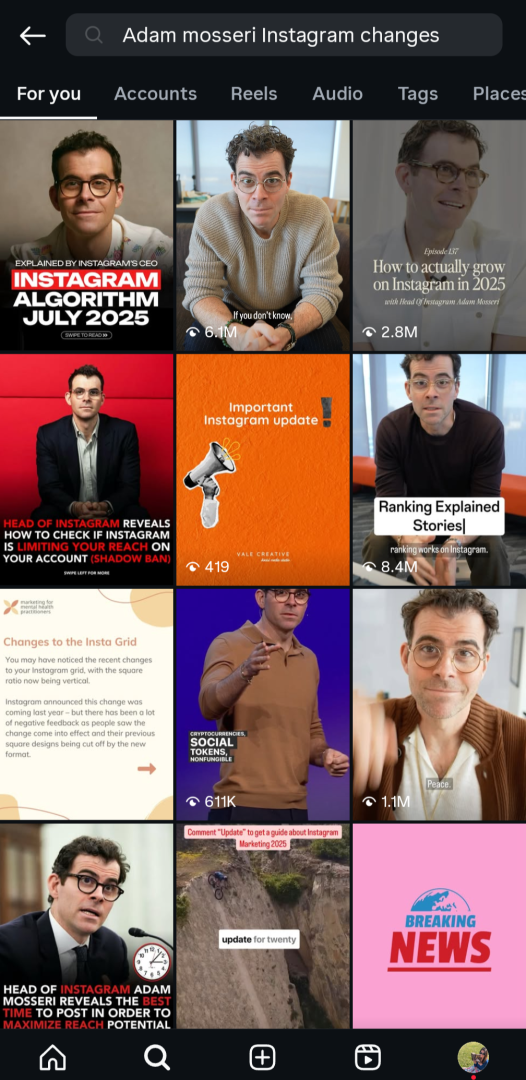The Ultimate Guide to Instagram SEO (2025 Tips)
Instagram isn’t just a pretty place to post pictures anymore, it’s a powerful search engine with its own algorithms, ranking factors, and opportunities to reach a wider audience. With over 2 billion monthly active users, Instagram is now a vital tool for brands, creators, small businesses, and agencies looking to grow visibility and attract potential customers.
We reported yesterday that public Instagram posts are now indexable by search engines. This is where Instagram SEO (Search Engine Optimization) comes in.
The good news is that if you’ve been using Instagram well for the past few years, you’ll already be in a good position to for your posts to be visible in Google searches. Since 2024, Instagram has made big moves toward becoming more searchable. Adam Mosseri, Head of Instagram, confirmed updates to how the platform ranks content, not just through hashtags, but by keywords in your captions, bio, alt text, and even spoken or text overlays in video content. As a result, Instagram users have upped their Instagram SEO game and have made changes to rank in Instagram’s search results. But now, the playing field has expanded.
Read more: Instagram Finally Rolls Out Keyword Search Function – What Does This Mean?
So how do you actually do Instagram SEO in 2025?
This is your ultimate guide, walking you step-by-step through strategies, examples, and tools to grow your reach and find your target audience through not only Instagram search results, but Google’s search results.
Click below to download our Instagram SEO checklist for 2025, and read on to find out more.
What is Instagram SEO?
Instagram SEO is the practice of optimising your Instagram presence to help you appear more frequently in searches, but as of the July 2025 Instagram update, this isn’t just on the Instagram app itself, but also on Google.
Previously Instagram SEO only referred to the practice of optimising your profile so that you would appear in Instagram searches, on the Explore page or in hashtag searches. This is a great way to grow your reach and following within the platform. But the game is changed now that Instagram SEO now also refers to the practice of optimising your posts for Google searches too – this means the potential audience of your Instagram posts has expanded exponentially. I can’t stress enough how much of a difference this could make!
It means that your Instagram posts and post captions now have the potential to appear in Google searches, even as featured snippets. We stumbled across the perfect example of this, where the search term “adam mosseri instagram changes” brought up a featured snippet from well optimised Instagram post:

What can we learn from this example?
The Instagram post that the content comes from does not have hashtags. Where previous Instagram SEO strategies would have included hashtags as a critical element, it’s clear that they are not necessary for Instagram posts to rank in Google searches.

“Hashtags are still relevant for in-app searches and from the earliest research into the new Instagram Google ranking factors, they appear to act as small ranking signals. However, we all know that Google doesn’t like the old-fashioned tactics of keyword stuffing, and lists of hashtags could be viewed like this. Remember the days when all you needed to do to rank was to chuck a list of keywords on your site?
“Embedding your keywords among high quality, relevant content is still going to be the best practice – matter if that’s on a blog post, category content, or even nowadays, an Instagram post.”
This is also a different piece of content that appears for the same search term on the Instagram platform itself, which shows that, while Instagram search factors mirror Google’s ranking factors, the Google algorithm and Instagram algorithm still operate differently.
And don’t forget that your Instagram algorithm will be personalised to you (it now appears under a “For You” tab on the Instagram search results), so my search for “adam mosseri instagram changes” first showed me a carousel post with a sound that’s trending among my peers at the moment.

Read more: 5 reasons you should target social media in an SEO campaign
Why Instagram SEO matters:
It’s not just about looking good. This new style of social search is about being found by the right audience, people who are already searching for specific topics, products, or services like yours. TikTok is already doing an excellent job of this, so it was about time that Instagram stepped up their game!
Here are a few key facts:
- Instagram’s algorithm now reads captions, alt text, and even on-screen words in Reels.
- Hashtag-only strategies are outdated, SEO keywords are the future.
- Ranking in Instagram search results and Google searches with your Instagram profile increases brand awareness and drives profile visits, follows, and conversions.
- For local businesses, showing up in location-based searches is the best way to get found by people nearby.
How Instagram’s Search Algorithm Works in 2025
When someone types into the Instagram search bar, the platform uses several ranking factors to determine what they see:
- Text relevance: Does your content (bio, captions, alt text, hashtags etc.) include the user’s search term?
- User activity: What content/accounts has the user interacted with before?
- Engagement metrics: Posts with higher likes, comments, and shares appear more
- Account info: Your profile name, handle, and category
- Content type: Instagram promotes high-performing Reels, carousel posts, and video content
Read more: 7 Ways for Businesses with under 10k Followers to Reach Customers on Instagram
Instagram SEO for Google – Ranking Signals
For your Instagram content to also appear in Google searches, we need to consider what Google is looking for. Google values content that is not only relevant, but is also engaging – that’s why the amount of time a user spends on a site or the amount of pages they visit are considered strong ranking signals in 2025. Social media platforms are, of course, the ideal place to demonstrate how well relevant users are engaging with your content. Instagram have now made it possible for Google to use engagements as ranking signals, so they play a crucial role in your Google search visibility.
1. Text relevance
2. Interactions and engagements
3. Follower numbers: These also need to be real users from relevant audiences. The Instagram and Google algorithms will be able to tell if you have thousands of bot followers!
4. Profile relevancy: Use natural keywords in your bio to advertise yourself to users and to search functions.
Read more: The Legacy of Dave Naylor and Bronco: Gaming Programmer to SEO Guru
5. Other posts relevancy: Google is more likely to recognise your post as an authoritative one if your other posts are on similar topics. We can’t use internal linking in the same way as we can on blogs, but it’s likely that a user that posts around a certain topic will build more authority than one who doesn’t normally post about that topic.
6. Hashtags: These are likely to be minor ranking signals to Google.
7: Image recognition: Just in the same way that Google image searches can recognise the content of images on other sites, they can use this to parse the images or videos found on Instagram.

A 10 Step Guide to Instagram SEO For Google
Step 1: Make sure your Instagram profile is public and professional
If your profile is set to private, your posts won’t appear in Instagram search results or on Google. That means new people can’t discover you unless they’re already following you.
To get found by a wider audience and make your Instagram SEO strategy actually work, your profile needs to be public.
Here’s how to check:
- Go to your Instagram profile
- Tap the menu (three lines in the top right)
- Tap Settings and Activity
- Scroll to Account Privacy
- Make sure the Private account toggle is turned off
- You will also need to ensure that “Allow public photos and videos to appear in search engine results” is toggled on.
You also need to be over 18 and have professional profile (either a Business or Creator profile) for your posts to be found.
A public professional account means:
- Your posts can be shown in Instagram search
- Your content can be found on Explore, in hashtags, and through Google
- You can attract new audiences and potential followers through organic social media posts
Step 2: Master Keyword Research for Instagram
You don’t need a whole SEO suite to find keywords for Instagram. Here’s a great way to do keyword research:
Use free tools:
- Instagram search bar: Start typing and see what it suggests
- Google Trends: Track topic popularity and seasonal interest
- Ubersuggest / KeywordTool.io: Look at long-tail phrases for niche audiences
- Hashtag tools: Try All Hashtag or Later’s Hashtag Suggestion Tool
Build a list of specific keywords you want to rank for, for example, “gut health snacks,” “Yorkshire dog bakery,” “bridal makeup tips”. Then use these to build your content strategy and calendar, create useful posts around them that users will actually want to engage with!
There are a lot of opportunities to post these keywords, but make sure that you do so contextually and in a relevant way:
- Your bio
- Instagram captions
- Alt text
- Hashtags
- Reel overlays
Step 3: Optimise Your Instagram Profile
Your Instagram profile is your homepage. It’s the first place Instagram looks when indexing your content, and is the place where you can build authority for Google searches. It’s also important for Instagram users too – don’t forget about user experience!
Best practices:
- Username (@handle): Make it simple and searchable. Include a target keyword if possible (e.g. @yorkshirecakes)
- Profile name: Instagram searches this. Add a keyword here too: “Yorkshire Cakes | Vegan Bakery”
- Instagram bio: Use clear, relevant keywords about what you do and who you serve. Continuing the example: “Vegan bakes for families in Leeds”
- Profile category: Use professional Instagram accounts to access this setting, pick a relevant one (e.g. “Restaurant,” “Digital Creator”)
- Location tag: Add a business address or location for local search
This is your chance to signal relevance for specific keywords, don’t skip it! Read more about how to do keyword research for Instagram SEO below.
Step 4: Nail Your Captions, Alt Text & Keywords
Captions are no longer just for vibes. In 2025, they’re essential for Instagram SEO work.
Instagram SEO tips for captions:
- Use target keywords near the beginning of the post caption
- Stay natural – write for humans, not just algorithms
- Tell a story or ask a question to boost user activity
- Add a CTA (e.g. “Save this post” or “Tag someone who needs this!”)
Don’t forget alternative text:
Instagram auto-generates alt text, but you can (and should!) edit it manually via Advanced Settings when posting. This is useful for users with visual impairments, but also gives Instagram and Google more opportunities to understand what your post is about – alt text supports both accessibility and searchability.
Include descriptive alt text with:
- A clear image description
- A relevant search term
- Additional context that a screen reader might need.

Step 5: Reels, Carousels & Video Content = SEO Gold
Video content is dominating feed and the Instagram Explore page. And even better news, Instagram now reads the text in your videos! We can only assume that Google will do the same, especially as it loves to promote video highly in search results nowadays.
Optimise video content by:
- Using text overlays that include keywords
- Always adding subtitles (better for accessibility and search)
- Writing keyword-rich Reel captions
- Adding location tags for local businesses
For carousel posts, include descriptive captions on every slide. Instagram analyses all of it.
Pro tip: Use voice-to-text tools to include keywords spoken in videos, Instagram’s AI is always listening!
Evergreen Useful Content vs Clickbait Content: What Actually Works?
In 2025, both the Instagram algorithm and Google search results are getting smarter. That means your content needs to do more than just grab attention, it needs to provide real value.
Here’s how the two content types stack up:
| Evergreen Useful Content | Clickbait Content |
|---|---|
| Timeless (can rank for months or years) | Short-term spikes, then dies |
| Answers real questions | Makes big promises, often doesn’t deliver |
| Helps users solve a problem or learn something | Prioritises emotion or shock value |
| High engagement: saves, shares, comments | Low engagement after the initial view |
| Builds trust and authority | Can harm credibility |
| Favoured by Instagram and Google | Less likely to rank long-term |
What counts as evergreen useful content on Instagram?
- How-to tutorials (e.g. “How to Start Fermenting at Home”)
- Myth-busting posts (e.g. “5 Fibre Myths Debunked”)
- Lists (e.g. “7 Gut-Friendly Snacks for Busy Mums”)
- Product explainers (e.g. “What is Cord Blood Banking & Why It Matters”)
- Tips, routines, and checklists
- Educational Reels or carousel series
- FAQs you’re always answering
This kind of content:
- Keeps working for you long after it’s posted
- Is more likely to be saved, which boosts engagement signals
- Aligns with Google’s desire to show helpful, relevant results
Clickbait-style content may seem tempting…
…but content like:
- “You won’t believe what happened next!”
- Overhyped transformations
- Generic “relatable” posts with no depth
…won’t win long-term. It may get likes, but it won’t rank, and that’s the game we’re playing with Instagram SEO now. Those posts can, however, help to boost your profile in Instagram and Google’s eyes though as an authority that people are willing to engage with, so as long as it’s relevant, go for it!
If you want to rank in both Instagram’s search results and Google’s, you need to create content that’s timeless, valuable, and helpful. Prioritise posts that people will come back to, not just scroll past.
Step 6: Engagement is Key
Respond to comments, encourage conversation in your captions, and create polls in Stories. These increase dwell time and signal engagement, both of which help Instagram’s algorithm, and potentially Google. Surface your content more by building a community – after all, isn’t that exactly what social media is for!
Read more: How to Grow Your Instagram Following Organically
Step 7: Use Hashtags the Right Way
Hashtags still matter, but only if they’re relevant, strategic, and not overused.
Hashtag SEO tips:
- Use 5–10 relevant hashtags per post
- Mix popular hashtags (over 500k uses) with niche-specific ones (under 100k)
- Include location tags (e.g. #YorkMums, #LeedsFoodie)
- Avoid banned or spammy tags. These are not just useless, but they can be limit reach on the platform.
- Don’t repeat the same hashtags on every post.
Hashtags now support ranking more than reach, they help Instagram and Google understand what your post is about, not just who to show it to. But remember to make sure that they are contextual hashtags! Don’t just use words that are relevant to your brand, but more specifically to your post.
Step 8: Timing, Scheduling & Consistency
The best times to post on Instagram vary by niche, but consistency is more important than chasing trends.
Best practices:
- Use Instagram Insights to find when your followers are online
- Post 3–5x a week, with a mix of Reels, carousel posts, and Stories
- Create a realistic posting schedule you can stick to.
Instagram rewards high-quality content, and repeated user activity on your account boosts future visibility in Google search results.
Step 9: Measure & Refine with Insights
You can’t optimise what you don’t measure.
Key performance indicators (KPIs):
- Search impressions: How often your posts appear in search results
- Profile visits
- Website clicks (from bio)
- Hashtag reach
- Follower growth
- Saves and Shares
Use Instagram Insights to track what’s working. Test changes to profile name, captions, or alt text and measure the results.
Tip: Try A/B testing similar posts with different keywords to see which performs better.
Step 10: Tools That Make Instagram SEO Easier
Make your life easier with the right tools to help to streamline your Instagram experience – otherwise you’ll spend your life chained to the app! Here are a few suggestions of tools you can use:
| Tool | Use |
|---|---|
| Later | Schedule posts, track hashtags |
| Canva | Design carousels with on-text keywords |
| Google Trends | Discover trending keywords |
| Ubersuggest | Find long-tail search terms |
| Hashtag Generator | Create niche tag sets |
| InShot / CapCut | Add subtitles and overlays to Reels |
Instagram SEO: Frequently Asked Questions
How do I make my Instagram account appear in Google?
To make your Instagram posts and profile appear in Google searches:
- Make sure your Instagram account is public
- Switch to a professional account (Creator or Business)
- Enable the setting: “Allow public content in search engines”
- Optimise your bio, captions, and alt text with relevant keywords
- Post high-quality, evergreen content that’s engaging and valuable
- Stay consistent with your posting schedule and monitor your analytics
Google indexes content that is relevant, engaging, and consistent. Think of your Instagram like a mini-website.
How to optimise SEO for Instagram?
Optimising SEO for Instagram means improving your profile and content so it appears in both Instagram and Google searches. Here’s how:
- Use target keywords in your bio, username, and captions
- Write clear, descriptive alt text for every post
- Use on-screen text and spoken keywords in Reels
- Add location tags for local visibility
- Post consistently and encourage real engagement
- Track performance in Instagram Insights and refine accordingly

How do I add SEO keywords to an Instagram post?
You can add SEO keywords to your post by:
- Using them naturally in your caption
- Including them in your alt text (via Advanced Settings when posting)
- Adding them to on-screen text in Reels or Carousels
- Including spoken keywords in your video’s audio (Instagram and Google both listen!)
- Adding relevant, non-spammy hashtags that reflect your topic
Is SEO the same as hashtags?
No, but they’re related. SEO involves optimising your content with relevant search terms to appear in Instagram or Google results. Hashtags are one way to signal what your content is about, but they’re no longer the most important ranking factor.
In 2025, keywords in your caption, alt text, and on-screen text carry more weight than hashtags alone.
Does SEO matter for Instagram?
Yes, SEO matters for Instagram more than ever! With Instagram content now being indexed by Google, SEO helps your posts get discovered by people outside of the app.
SEO matters because it:
- Increases your visibility in both Instagram and Google
- Brings in qualified leads and followers
- Helps you show up for relevant search terms
- Builds long-term authority on specific topics
How to boost the algorithm on Instagram?
To boost your visibility in Instagram’s algorithm:
- Post content that encourages engagement (saves, shares, comments)
- Use keywords in captions, alt text, and profile
- Mix up your formats: Reels, carousels, Stories
- Respond to comments and DMs
- Post consistently (3–5x/week is ideal)
- Use on-trend sounds or formats in Reels
- Keep viewers watching (especially for video content)
Instagram’s algorithm prioritises content that’s relevant, consistent, and engaging.
Is it better to use keywords or hashtags on Instagram?
Use both, but keywords are more important for Instagram SEO in 2025. Hashtags help categorise your content, but Instagram now indexes text in your:
- Bio
- Captions
- Alt text
- On-screen text
Focus first on creating natural, keyword-rich captions and use 5–10 relevant hashtags to support them.
How to find SEO keywords for Instagram?
Start with these free tools:
- Instagram Search Bar: Type a word and see auto-suggestions
- Google Trends: Find seasonally relevant search terms
- Ubersuggest / AnswerThePublic: Find long-tail questions and keyword phrases
- Your own DMs or FAQs: What are people asking you?
Look for keywords that your target audience is searching for, then weave them into your Instagram content strategically.
Read more: The Power of Social Media Marketing: Top tips to help you get the most out of your business
Your 2025 Instagram SEO Strategy Checklist
Instagram has become more than just a social media app, it’s a search-first platform, shaped by both user intent and traditional SEO principles, and more importantly, it’s now a key place to get your content out into the world via external search engines. Whether you’re a creator, an agency, or a local business, understanding and applying Instagram search engine optimization can drive brand awareness, unlock new audiences, and give you a serious competitive edge.
Stop thinking of Instagram SEO as optional. Start thinking of it as your growth engine.
- Optimise your profile name, handle & bio
- Use keywords in every caption, Reel, and alt text
- Use location tags for local discovery
- Write custom alt text for accessibility & SEO
- Use strategic, relevant hashtags
- Post at the right time using a consistent schedule
- Use subtitles and on-screen text in Reels
- Measure and test everything
- Use the right tools
- Think like a search engine
If you need a hand with your Instagram SEO, contact Bronco today!
